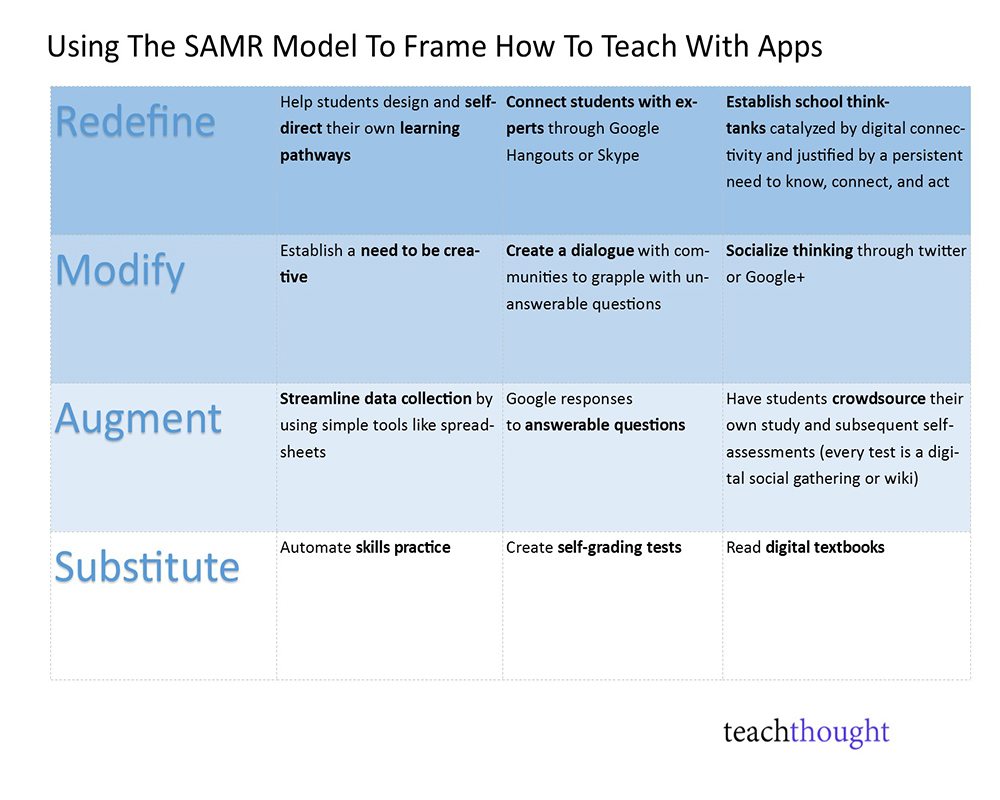Using The SAMR Model To Frame How To Teach With Apps
How To Teach With Apps Using The SAMR Model by TeachThought Staff Not all apps are created equal. Not all teacher planning and instructional design are created equal. Mash the two, and we’re beginning to see the opportunity for some real disparity. In response, we’ve taken the popular SAMR model and use it as a…
How To Teach With Apps Using The SAMR Model
by TeachThought Staff
Not all apps are created equal.
Not all teacher planning and instructional design are created equal.
Mash the two, and we’re beginning to see the opportunity for some real disparity.
In response, we’ve taken the popular SAMR model and use it as a framework to understand how to better teach with apps.
This post started as a look at “app workflow”–the patterns of student and teacher interaction, the movement of learning artifacts, the visibility of quality criteria, assessment results, and so on, but we thought it might be better to start with some concrete examples of the movement from basic technology integration–in this case, apps–to that which redefines the learning process entirely.
Below, then, are 21 ways apps can be used to teach–and learn–with varying degrees of ambition, from mere substitution of existing teaching practices, all the way to full-on redefinition of what’s possible. (This post also presumes you’re familiar with the SAMR model–if not, here’s a good primer.)
SUBSTITUTION
Use apps to…
1. Automate skills practice
2. Create True/False and other basic assessments using Google Forms
3. Create self-grading tests
4. Read digital textbooks and respond to multiple choice or short-answer questions
5. Type essays, report, or PowerPoint (using Microsoft Word or Apple Pages, for example)
AUGMENTATION
Use apps to…
6. Streamline data collection by using simple tools like spreadsheets
7. Leverage learning algorithms (like Knowji)
8. Google responses to answerable questions
9. Maintain a digital portfolio of academic work
10. Have students crowdsource their own study and subsequent self-assessments (every test is a digital social gathering or wiki)
MODIFICATION
Use apps to…
11. Establish a need to be creative
12. Start–and end–with a connection. Connect student to student, teacher to student, student to teacher, teacher to parent, or student to parent
13. Create a dialogue with communities to grapple with unanswerable questions, then curate the results (through a community like reddit or Quora)
14. Elegantly design a digital portfolio of authentic work students have affection for
15. Socialize thinking through social media
16. Help students gather spontaneously for mobile and self-sustained study groups
REDEFINITION
Use apps to…
17. Help students design and self-direct their own learning pathways
18. Embed students in authentic local—physical and digital–communities
19. Connect students with experts through Google Hangouts or Skype (here’s a handy framework for that as well)
20. Use mobile, scenario-based or project-based learning
21. Establish school think-tanks catalyzed by digital connectivity and justified by a persistent need to know, connect, and act
Using The SAMR Model To Frame How To Teach With Apps
